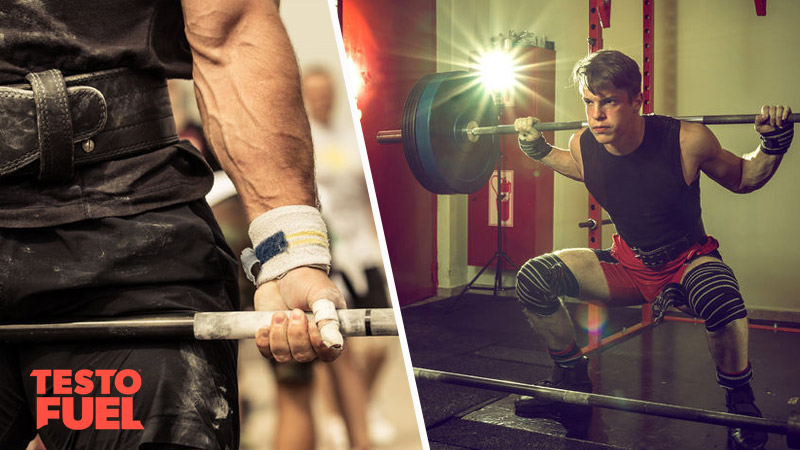TestoFuel Blog : Make Gains & Pack on the Muscle

When it comes to boosting your testosterone levels or packing on muscle mass you need to weaponize your arsenal from every angle.
This means you need the best supplements, an optimal diet and a training program that’ll push you to your limits. You need to think clearly about rep ranges, exercise selection and overall approach.
In this article we’ll tell you why heavy weightlifting is the best way to boost your testosterone levels. Read on to find out more…
Testosterone (T) is a naturally occurring steroid hormone that plays an important role in male health and performance.
Produced n the Leydig cells of the testes, T is a androgen which means it is responsible for regulating a number of masculine traits and characteristics.
It is regulated by a part of the brain called the hypothalamus. Together with the testes it forms a loop called the hypothalamic-pituitary-gonodal (HPG) axis . The specialized bundle of small nuclei in the hypothalamus sends a hormone called gonadotropin-releasing hormone (GnRH) to its next door neighbour – the pituitary gland.
Once the pituitary gland receives this hormone, it releases its own hormones called Luteinizing hormone (LH) and follicle-stimulating hormone (FSH) into the main circulation of the bloodstream. These hormones then bind to receptors in the Leydig cells and testosterone is released.
Normal T levels for a man should fall between 300 and 1000 ng.dL, with mean average concentrations sitting at about 724 ng.dL in healthy, fit men [1].
When optimized, testosterone regulates everything from bone mass to libido. Our male hormones have two categories of effects:
One of the major contributions that testosterone provides you with is the regulation of muscle mass.
As we age though out testosterone levels can naturally start to drop. As soon as this happens, you’ll lose strength and muscle mass, your protein metabolism will be lower, and a decrease in physical performance will occur.
It is therefore paramount that you do all you can to fight against it using diet, supplementation and exercise.
The mere inclusion of weight training positively effects testosterone. A study by Fry et al [2] found that even when men only lifted 70% of their body weight for 5 sets of squats, testosterone levels rose higher than men who didn’t train.
But there’s a very strong relationship between how heavy the weight you lift is is too.
For example, a study by Häkkinen et al [3] found that 6 months of heavy resistance training in combination with explosive exercise increased concentrations of both total and free testosterone as well as growth hormone significantly. The volunteers also improved strength, maximal muscle activation and 1RM too.
Interestingly it only took one workout for testosterone levels to begin to increase.
Similarly, a 21-week study conducted by Ahtiainen et al [4] found that strength was well correlated with both testosterone and muscle size. This led the research team to confirm that T is an important regulator of muscle mass.
So which lifts give you most bang for your buck? So far all of the research points to compound exercises.
These are characterized by multi-joint, multi-muscle lifts such as squats, deadlifts, presses and pulls. The more muscles are activated during the exercise, the better. They let you lift far heavier than single-joint exercises purely because you can activate more muscle.
A study published in the Scandinavian Journal of Medicine and Science in Sports [5] found that more muscles involved in training led to both improvements in strength and increases in anabolic hormone levels.
World renowned expert William J Kraemer [6] also found that compound exercises were more effective than isolation exercises for boosting testosterone too. In his study, a group of 20 elite weightlifters were given wither a heavy weightlifting program consisting of compound exercises or the less effective a lower intensity workout.
Not only does the magnitude of hormone release relate closely to the amount of muscle involved; bigger lifts also promote better protein synthesis. This in turn leads to bigger muscles. Compound exercises help to stress more muscles and this leads to better overload – a key indicator of muscle growth.
So ditch the bicep curls and start to lift some heavy stuff! Replacing your flyes with bench presses, leg press with squats and triceps kickbacks with dips will make all the difference.
By now you know that you need to lift heavy to elevate your testosterone levels. But how heavy?
The research we’ve discussed above used loads of around 85% of your 1RM or more. So dig in deep and start to load the bar up.
There’s no need to work on isolation exercises to optimize your anabolic hormones. Focus on lifts that maximize muscle groups. Rows, deadlifts, overhead presses, squats, pull ups and bench presses are the way forward.
When you’re training big and using complex lifts you need to ditch the split training approach and think full body. Organizing your sessions into either ‘upper body – lower body’ or ‘push – pull ‘ gives you an opportunity to work all of your major muscles in one go.
And as we know, more muscle equals higher testosterone.
If there’s one thing that research tell us, it’s that loading up the bar and lifting heavy optimizes testosterone levels.
Ditch the side bends and bicep curls and start to put in more challenge squat, pull and press movements to really boost strength, hormones and muscle mass.
For more training programs check out Boss Workouts the number one workout website.